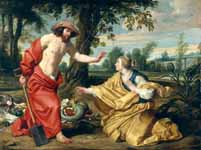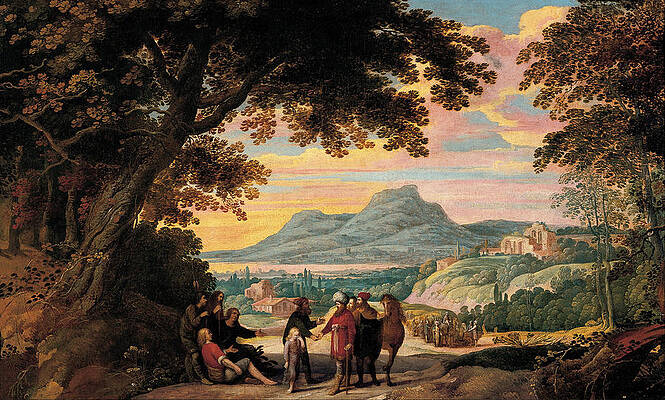Jan Wildens or Jan van Wildens
Paintings
Joseph sold by his Brothers
Landscape with Dancing Shepherds
The St. Bernard Abbey in Hemiksem


Winter Landscape with a Hunter

Act of Devotion of Rudolf I of Habsburg, Peter Paul Rubens and Jan Wildens
Fine Art Prints | Greeting Cards | Phone Cases | Lifestyle | Face Masks | Men's , Women' Apparel | Home Decor | jigsaw puzzles | Notebooks | Tapestries | ...
Jan Wildens (1586 in Antwerp – 16 October 1653 in Antwerp) was a Flemish Baroque painter and draughtsman specializing in landscapes.
Life
Wildens was born in Antwerp and at the age of ten was apprenticed to Pieter van der Hulst (I) (d. 1628). He became a master of the Antwerp Guild of St. Luke in 1604. He travelled to Italy in 1613 or 1614. Around 1615-1616 he created a series of 12 landscape drawings representing the 12 months of the year, which were also published in print form by Hendrik Hondius. Upon returning to Antwerp after a stay in Italy of three years, he became a frequent collaborator of Peter Paul Rubens until 1620, even though Wildens was never formally employed by Rubens.[1][2]
In 1619 Wildens married Maria Stappaert with Rubens acting as a witness at the wedding. Maria's niece Hélène Fourment would become Rubens’s second wife. Maria Stappaert died in 1624 after bearing Wildens two sons, both of whom became painters: Jan Baptist (1620–37) and Jeremias (1621–53). In 1624 Wildens opened a picture gallery which was very successful and would later be run by his son Jeremias.[2] When Rubens died in 1640, Jan Wildens acted as a testamentary executor.[3]
His pupils included his sons Jan Baptist and Jeremias and Hendrick van Balen the Younger.[4]
Work
Landscape with Christ and his Disciples on the Road to Emmaus, 1640s, Hermitage Museum
Jan Wildens painted mainly landscapes. The compositions of his early landscapes before his stay in Italy were influenced by artists such as Gillis van Coninxloo, Jan Brueghel the Younger, Joos de Momper and Adriaan van Stalbemt.[2]
In Italy he discovered the landscape art of his compatriot Paul Bril with its realism and eye for detail.[3] Upon his return to Antwerp, Wildens became a frequent collaborator with Rubens. He was responsible for the landscape backgrounds of various scenes in the designs of Rubens for the Decius Mus tapestry series and many history paintings by Rubens, including The Rape of the Daughters of Leucippus (c. 1618; Alte Pinakothek, Munich),[5] Samson and the Lion (c. 1618; Private Collection), Cimon and Iphigenia (c. 1617–18; Kunsthistorisches Museum, Vienna)[6] and Diana and her Nymphs Departing for the Chase (c. 1616; Cleveland Museum of Art). Later in his career he painted landscapes for many other Antwerp painters such as Jacob Jordaens, Frans Snyders, Paul de Vos, Abraham Janssens, Jan Boeckhorst, Gerard Seghers, Theodoor Rombouts and Cornelis Schut.
His work in the 1620s and 1630s employed decorative forms, loose compositions and a broad technique reminiscent of Rubens, though earlier influences on him such as Jan Brueghel the Younger and Paul Bril still continued to play a significant role. Wildens preference was for a calm and gentle approach expressed in marked symmetry of composition and soft, subtle colours. The contrast with Rubens is evident in Wildens’ serene Landscape with a Shepherd (Royal Museum of Fine Arts Antwerp), which was partly inspired by Rubens’s more dynamic Landscape with a Shepherd and his Flock (National Gallery, London).[2]
After 1640, he adopted the rather sketchy method and the vibrating, atmospheric light that Rubens used in his own later landscapes. The works of this period also display an increased dramatic element.[3]
Sources
Joannes Wildens biography in : Arnold Houbraken, De groote schouburgh der Nederlantsche konstschilders en schilderessen, 1718 (Dutch)
Hans Devisscher. "Wildens, Jan." Grove Art Online. Oxford Art Online. Oxford University Press. Web. 19 Jul. 2014
Matthias Depoorter, Jan Wildens at Barok in Vlaanderen
Jan Wildens at the Netherlands Institute for Art History (Dutch)
The Rape of the Daughters of Leucippus by Rubens
Cimon and Iphigenia by Rubens
Further reading
Hans Vlieghe (1998). Flemish Art and Architecture, 1585-1700. Pelican History of Art. New Haven: Yale University Press. ISBN 0-300-07038-1
----
Fine Art Prints | Greeting Cards | Phone Cases | Lifestyle | Face Masks | Men's , Women' Apparel | Home Decor | jigsaw puzzles | Notebooks | Tapestries | ...
----
Artist
A - B - C - D - E - F - G - H - I - J - K - L - M -
N - O - P - Q - R - S - T - U - V - W - X - Y - Z
Retrieved from "http://en.wikipedia.org/"
All text is available under the terms of the GNU Free Documentation License







